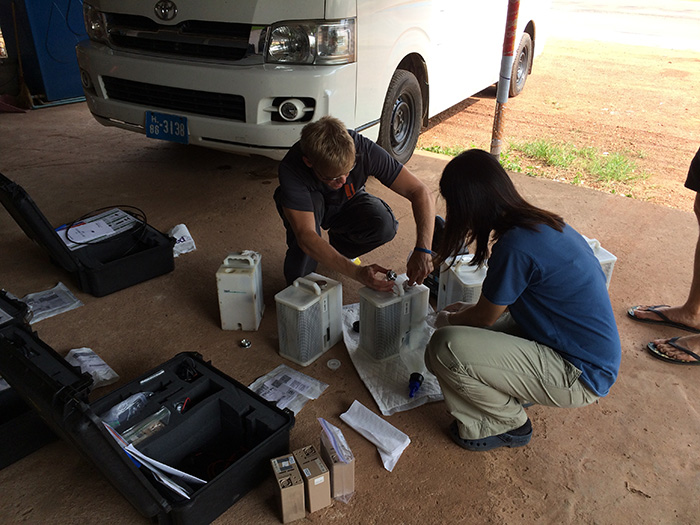MSS PMO Personnel Attract Mosquitos in Thailand

Representatives of the U.S. Army Medical Materiel Development Activity's Medical Support Systems Project Management Office traveled to Kamphaeng Phet in Thailand in November to evaluate the efficacy of Carbon Dioxide Generator technologies in attracting dengue-vector mosquitos.
Jake Fox, MSS PMO product manager for the CDG program, and Dr. Kendra Lawrence, senior scientific consultant for the USAMMDA, spent two weeks evaluating the efficacy and functionality of the CDG systems in partnership with the Armed Forces Research Institute of Medical Sciences unit in Thailand.
"They have lots of malaria vectors, lots of dengue vectors and well-established field sites," said Lawrence, who helped design the experiments and arrange the evaluations at Kamphaeng Phet.
Over the course of the twelve-day period, the team evaluated four CDG systems in combination with the Centers for Disease Control and Prevention miniature light trap. CDG systems are designed to increase the effectiveness of the light traps by introducing another attractant.
According to Lawrence, insects that subsist on blood are not always drawn to light, but they are drawn to the carbon dioxide emissions of mammals that provide a blood-meal source.
"They use [carbon dioxide] as a cue to hone in on their host," said Lawrence. In an operational environment, those hosts are often Soldiers.
Malaria, dengue fever and leishmaniasis, which top the military's list of vector-borne diseases, are transmitted by mosquitos and sand flies attracted to CO2, Lawrence said. Preventive medicine units deployed to areas of operation that present a significant risk of these disease vectors, like the hot and humid climate in Thailand, use vector traps to determine appropriate protective measures for vector control.
"It gives you an idea ... where to look for the larvae, and what kind of spraying to do, what time of day to be doing it and so forth," said Lawrence.
The team evaluated the CDG and light trap combinations against the CDC light trap alone as a negative control, and against the CDC light trap with dry ice - the form of carbon dioxide currently used - as a positive control. None of the CDG systems were able to surpass the dry ice, which Lawrence calls the "Gold Standard" for vector attractants, in terms of the number of mosquitos attracted to the traps.
"To beat dry ice, or even to be as good as dry ice, is pretty hard," said Lawrence.
Despite its high efficacy status, however, dry ice has its drawbacks. It must be transported and stored in coolers due to its rapid sublimation rate, which is the rate that the ice turns to gas. A sizable cooler filled with dry ice might last a week, Lawrence said, but in areas where dry ice isn't readily available, resupply can be "logistically pretty difficult."
"In most contingency operations ... you're going to places where they don't make dry ice," said Lawrence.
CDG systems are designed to solve this problem by producing a more portable and accessible source of CO2 gas. The systems evaluated in Thailand used three different methods of CO2 production. Two used acid-base reduction, while another used an acid solution with electrolysis. The fourth system used combustion to produce CO2 in the exhaust. "Similar to that of a car," Fox said.
Of the CDG systems tested, Fox said only one - the system from TDA Research in Colorado - proved effective in a real-world environment, based not only on standards of efficacy in capturing the dengue-vector mosquitos, but also operability and reliability. Lawrence notes, however, that in terms of the number of mosquitos attracted, "most of them did better than the light trap alone."
Two of the systems evaluated in Kamphaeng Phet, TDA Research and CUBE Technology in Arizona, participated in the DOD's Small Business Innovative Research Program. The other two generators evaluated were commercially available systems from Overnia in Connecticut and Med-e-Cell in California.
Fox expects data from the recent Thailand trip, as well as data from trials conducted last May against malaria vectors in Mae Sot, Thailand, will support the decision to continue development of the CDG systems.
"We expect Milestone B and permission to enter the Engineering and Manufacturing Development [phase] in the third quarter of fiscal year 2015," said Fox.
The team plans to travel to Greece this July to conduct evaluations against leishmaniasis vectors.
"The plan is to take some, but not all of the devices, to ... test them against sand flies in collaboration with the USDA lab that is there," said Lawrence.
According to Fox, if evaluation trials continue to go well, the CDG system could be ready for initial operational capability in fiscal year 2016.














